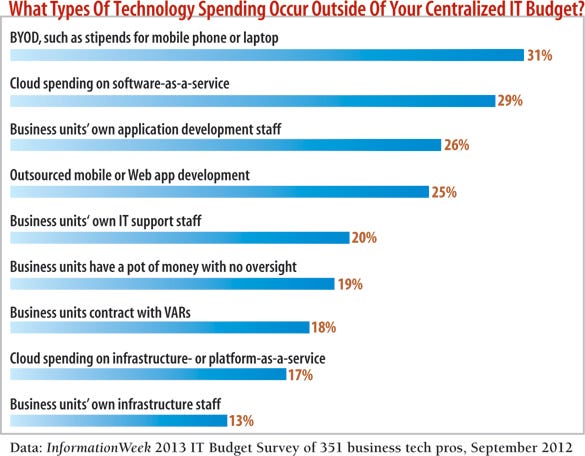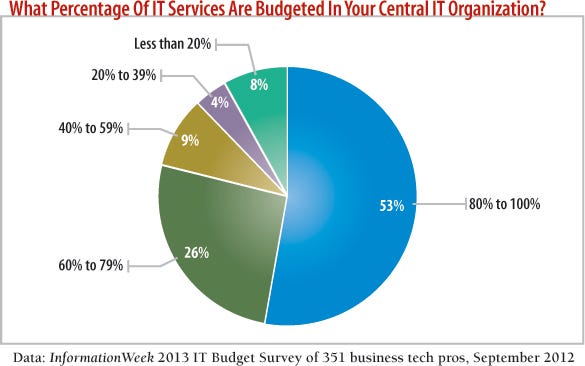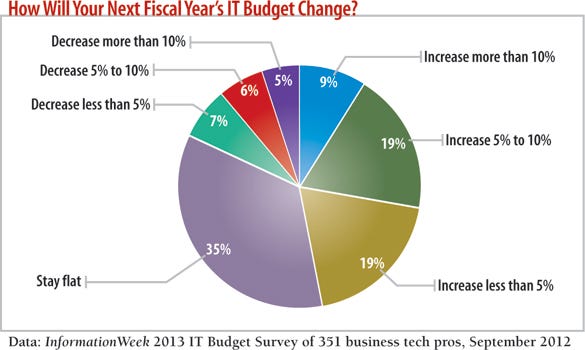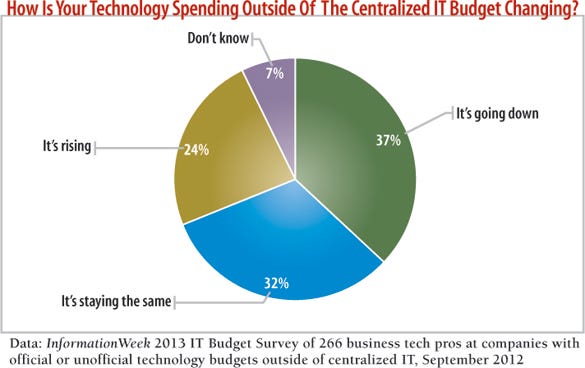IT Has Changed, But IT Budgets Haven'tIT Has Changed, But IT Budgets Haven't
IT's role is shifting to focus more on innovation and driving revenue. So why are budgeting practices so stuck in the past?

The demands on IT departments keep changing, but their budgeting processes aren't keeping pace.
Those that succeed have this in common: a relentless drive to increase business productivity and cut costs, but also the creativity and agility to drive new business opportunities and revenue. The expectation for IT to drive revenue is new at many companies. In this year's Society for Information Management survey, for example, "revenue-generating IT innovations" is among the top five priorities, in fourth place, for the almost 200 respondents for the first time in the 14 consecutive years of the survey. Two years ago, it was 17th on the priority list.
Yet the IT budgeting process at most companies still looks like the same old exercise in containing IT costs. Need to take on an unexpected expense? Just one-fourth of the 351 respondents to our own IT Budget Survey have a formal process to deal with such changes, while one-third rely on "ask the CEO." How about setting the future direction for this critical spending? Just 22% of respondents to our survey say their IT governance board has a major influence on the IT budget. Another 35% say it has some influence, which isn't bad. But 43% say they don't have an IT governance board at all, or it has little influence on spending. "The budgeting process is crucial, yet as these are prepared so far in advance of the fiscal year, they tend to change significantly based on business and/or IT requirements or initiatives," laments one IT pro in our survey. "... A common concern shared in our IT groups is the resemblance--or lack thereof--of the forecast with actual spend."
And it's more than IT's new place in business innovation and revenue generation that's putting new demands on the budget process. Forces such as IT consumerization, cloud computing, and the rise of marketing-initiated IT spending have some people thinking that centralized IT is dead. Good-bye, IT control freaks; hello, business unit freedom! Is the answer to just push all of those budgeted IT dollars out into lines of business? Our data suggests central IT budgets are in fact far from dead--eight out of 10 still centralize most IT spending, and for good reasons.
IT organizations aren't on a starvation diet during this time of change: 47% of respondents to our survey expect to get an increase in IT spending next year, and just 18% expect a cut. That's similar to our last survey, in October 2010, but the levels appear up--only 18% say their IT spending is less than 3% of the total operating budget, compared with 43% in 2010.
Look at the technology areas that are getting funding outside of the IT budget, and you see that many of them are poised to grow: cloud software as well as mobile and Web app development, for example. IT budgeting hasn't changed much to account for these trends, but don't expect it to stay stagnant for long.
Get the full-length IT budget report
>> See all of our reports <<
Death Of Centralized IT? Hardly
You'd be forgiven for thinking centralized IT budgets are dying because business units are taking their technology spending into their own hands. The argument goes something like this: Consumerization of technology and cloud software make it possible for non-IT employees to provision their own technology. As technology becomes more critical to lines of business, it makes sense for them to buy and run more of it. Look at the rise of cloud-based marketing software for digital campaigns and customer analytics, and consider the oft-cited Gartner prediction that the CMO will control more tech spending than the CIO within several years (see "6 IT Trends Tight Budgets Won't Kill").
Our data doesn't suggest a drop in centralized IT spending just yet. About eight of 10 companies represented in our survey have centralized 60% or more of their IT spending--up from two-thirds of companies two years ago. The share of companies with 80% or more of their IT spending centralized has held steady, at around half. But the share of survey respondents whose companies have centralized less than 40% of their IT spending is down to 12%, from 23% two years ago (see chart on next page).
Still, our data does show the tension around business units buying more technology. While 37% of survey respondents say outside-of-IT tech spending is decreasing as they get their arms around "shadow" buying, another 24% say their tech spending outside of the IT organization is on the rise. Bring-your-own device efforts, cloud software, and application development are each cited by at least one-fourth of survey respondents as getting funding outside of IT (see chart below). And three-fourths of the IT pros we surveyed say there's either official or suspected unofficial technology budgets that exist outside of IT.

Mobile, Cloud, And Marketing
As business units start buying or bringing in their own cloud services and mobile devices, it's easy to get caught up in the hype and predict the end of centralized IT. Most everyone can buy from Amazon Web Services without IT intervention, so why should our next enterprise app need IT support? Best Buy and 4G hotspots for everyone!
Consumerization, cloud, and social and mobile marketing are all incredibly important trends that are creating chaos for IT, but a little bit of critical thinking is in order. Just because there's some business unit funding for these efforts doesn't mean that all funding tied to them gets decentralized. For example:
>> Consumerization: Yes, 31% say business units have some BYOD funding, such as stipends for phones and tablets. But does anybody really think the marketing and finance folks are going to figure out how to implement such devices in a secure manner that satisfies company confidentiality, integrity, and availability standards? BYOD causes enough security problems without turning responsibility for it over to amateurs. Business units may control device stipends and choices, but they won't control the overarching security and wireless infrastructure, as well as their companion technology, mobile device management.
>> Software-as-a-service: Twenty- nine percent of the respondents to our survey say business units at their companies have their own funding for SaaS. But there are deeper implications when an IT organization rents, not owns, critical infrastructure, including uptime and the risk of giving up control of assets critical to the health of the company. Despite the lemming-like rush to SaaS, many critical applications will stay on premises because of long-term ownership issues.
>> Marketing and social media: Will marketing departments pick up and perform IT's duties? "I think it's nuts," says Tom Smith, director of operations and marketing for the U.S. subsidiary of Anua, a provider of wastewater management and other control systems. Smith has been in marketing for 30 years, and he notes that his company still relies on design, copywriting, and other third parties to do some of its core work. As the director of operations, he also supervises an outsourced IT organization, but he has no illusions that the infrastructure or security duties of a centralized IT operation can be performed by marketing folks.
At Sears Holdings, the IT team is trying to push analytics work into the business units, giving them tools to write their own queries on data, for example, rather than have to ask IT for a report. But IT still runs the infrastructure to deliver the data, and it does the complicated architecture work to make sure data is accessible and quickly available.
Could marketing end up spending more than the IT department on technology--or even controlling IT? There have been crazier, Dilbert-worthy fads. And perhaps it could make sense at some marketing-driven companies. But keep this notion in perspective. For a long time, IT reported to finance at most companies. Some banks now have IT report to an operations and technology executive. But that doesn't mean that central IT goes away, any more than central IT disappeared back when IT reported into finance. Someone will still need to budget centrally for "whoever" is going to handle critical internal infrastructure, security, data integration, etc., unless someone thinks it's possible to coordinate the chaos of IT staff, projects, and budgets in every business unit making its own tech decisions.

Funds For IT Innovation
The yearly IT budget remains a fixture--64% of the respondents to our survey say their company does an annual budget; only 23% do quarterly or twice-a-year budgets. But it's not necessarily the cycle that's problematic. It's that, as one technologist in our survey put it, "budget requests, approvals, and tracking are too cumbersome." Only 18% of survey respondents think their budgeting process is very flexible.
Contrast that lack of flexibility with the expectations of IT: Be agile and innovative. "Sounds like all departments nowadays," says Anua's Smith. Fair enough, but that only means the budget process is a challenge for everyone.
Budgeting is based on modeling the future. But your job as an IT leader is to react to reality. A piece of infrastructure dies, and maybe someone approved discretionary money to replace it, or maybe not.
Your environment gets massively infested with malware, and the cleanup soaks up all of your contracted services funding. Or hopefully, you've come up with an idea to make IT run for less, or to make your colleagues more efficient or your products better. Good luck with any of these, and especially those last two, if you budget for subsistence IT. An essential question for IT leaders is whether their IT budgeting matches the level of tech innovation they expect.
At Sparrow Health Systems in Michigan, healthcare IT spending is the single largest capital expenditure right now--something that's mind-boggling given the other big capital items required by a large healthcare provider. That spending decision came from an executive board that had a "Walmart moment," says Patrick Hale, Sparrow Health's CTO, referring to the strong IT systems that helped give Walmart an advantage over its competitors during its big growth years. "Better healthcare outcomes will come from technology-backed analytics, and this is reflected in our budget," he says.
Sparrow's executive leadership intentionally and strategically raised IT spending with the goal of raising overall business excellence. "We're not spending a lot of money to be mediocre," Hale says. "We're spending a lot of money to lead in healthcare."
Sparrow shows how the budget process reveals a company's leadership and organizational priorities. Hale's leadership prioritizes IT as a major asset--and Sparrow funds it accordingly.
Likewise, it reveals something unflattering about IT planning generally that the No. 1 strategy IT leaders use to deal with unexpected expenses is simply to ask the organization's CEO. No. 2 is a formal process to ask the CFO or similar budget exec.
In organizations that prioritize IT, we would think that IT would at least have a formal request process, or even better some sort of capital reserve or managed savings--let the CIO make the decision to reduce other areas without substantially affecting operations or initiatives before having to use the "mother, may I?" strategy.
This kind of discretion isn't the same approach used by the 6% of companies in our survey that have a slush fund, where they overestimate costs or keep a reserve in their base budget. Intentionally overestimating costs is very different from adding a contingency that's acknowledged and accounted for, and such a slush fund is a sign of a dysfunctional business-IT relationship. IT is planning for a "no" from executive leadership and feels the only choice is to, well, cheat.
Good IT governing boards must help prioritize funding for innovative projects and respond to unanticipated projects and expenses. But the governing board's role at the companies we surveyed is all over the map. Close to one-fourth of survey respondents say they have a board with major influence, about one-third have some influence, and then 21% have weak boards and 22% have none.
Governance is a great answer--when it works right. But if it only means that the CIO goes begging to four or six people, you're better off with no governance--it's easier to just go begging to the CEO or CFO. But if governance is a shared responsibility between the CIO and line-of-business leaders, budgeting can get a whole lot smarter.
A company like UPS shows how good governance, like budgets, can flex to changing business needs. UPS has been developing software for its drivers' mobile devices for decades, but in the past year it created a small, agile team to keep up with the blazing pace of consumer smartphones and tablets. People in IT, marketing, and communications deliver new mobile functions about every month. The team has learned many lessons, one of which is that writing software for customers isn't for the meek. "In the mobile world, in the social world, feedback is almost instantaneous," says Nick Costides, a UPS VP of IT who built the mobile team. "It has forced the developers to have some pretty tough skin."
But they've learned something else: Governance has to move at that same pace. The group has a mobile governance committee that includes Costides and leaders of product marketing and communications. So as quickly as devices and the mobile market change, UPS can change its road map and investments. The point? You can't have a nimble governance and resource allocation process with a governance team that meets twice a year.

How To Benchmark Chaos
It's easy for IT pros to feel like they're under-resourced. But are they? One part of the answer comes from benchmarking budgets against other companies. Yet three out of 10 IT organizations we surveyed don't compare their budget efficiency with other organizations'.
That's a lost opportunity. As more business units make their own technology investments, IT could provide expert services for tracking costs and calculating ROI.
The most popular budget efficiency metric with tech pros in our survey (cited by 37% of respondents) is IT operating budget as a percentage of the corporate operating budget, followed by IT operating budget as a percentage of revenue (31%), and cost per employee served per year (16%).
Sadly, "IT employees as a percentage of all employees" isn't dead as a metric; 13% of survey respondents said their companies still use it. Do you want a metric that can be gamed by using contractors instead of employees?
IT also has been doing more transaction budgeting--tracking IT costs on a per-unit basis. For example, the two big growth areas for this kind of tracking are calculating costs by work order (up 10 points to 24% of companies) and by IT personnel service hour (up eight points to 19%). Transaction-based budgeting looks here to stay: In 2010, 54% of companies said they did no budgeting that way, and this year, 37% say they do.
The practice of chargebacks to business units for IT services is always controversial. A means to achieve accountability, or needless accounting overhead? As in 2010, about 60% of companies represented in our survey charge back or plan to charge back for some or all of their IT services. The share that charges back 100% of IT dropped from 17% to 9%. Among those doing chargebacks, the majority charge back less than 40% of their total IT costs.
One survey respondent whose company is trying to go to a pay-for-service model says: "Some business units will disagree with this model, as they are used to receiving large amounts of data center services for 'free.'" Yes, but be careful. If you start charging per CPU hour, unless you have massive scale, you're going to get shellacked by Amazon's and Google's cheaper cloud computing rates. Hello, commodity! If internal IT's CPUs offer something those vendors can't, be ready to explain your cost premium.
Showback--whereby IT costs are reported to business units but not billed--is less controversial but still quite effective. About half of companies in our survey use this model, and of those only 8% say it's not worth it. There's no better way to connect IT with business activities and for business unit leaders to know if they're high utilizers. Sometimes being a high utilizer is just fine, and it'll highlight a vital business unit-IT tie. Letting business units see their costs compared with others is the most-cited benefit from a showback approach.
Unfortunately, showback and chargeback accounting are tedious to set up, and they come with an ongoing expense. Have a clear objective before going down this road. These activities are prone to misinterpretation, so have a process for discussing the results regularly with business units and acting on problems.
Even though this kind of measurement and transparency comes with risk, IT can't shy away from it, and should in fact push for more of it. As business units such as marketing and product development start spending more on technology, these kinds of budgeting approaches should be discussed openly to make them a strategic choice. If marketing's buying and running its own servers, make sure everyone's aware of it.
Given the budgeting changes that IT's changing priorities will require, IT looks a bit complacent: 60% are very or somewhat satisfied with their budget process. And yet four out of 10 survey respondents admit that there's tech spending outside of centralized IT that their company doesn't officially recognize. Half think their company's budget process isn't consistently flexible enough for changing business needs. Three-fourths don't have a formal way to address unforeseen expenses. And barely half think the company will add enough IT resources to meet business objectives as the needs change.
So, how can you take all of this and create a plan of action to improve business technology budgeting at your organization? Here's a short list:
>> Govern right: Build a governance model that's participative, not mother-may-I.
>> Display agility: You can't ask for budgeting flexibility if IT operations and project delivery aren't flexible.
>> Benchmark: Comparisons create credibility that will emphasize that budget requests are reasonable.
>> Tell a story: Executives are inundated with "IT is dead, just push it to the cloud" stories. They need to hear what makes your work special--from you and the business leaders you're partnering with on projects. Ongoing communications, including quarterly reporting, focus groups with business units, and other PR-type activities, convey essential information. This effort might seem far removed from the cold, hard numbers of budgeting, but a good story is part of any business case.

Go to the sidebar:
6 IT Trends Tight Budgets Won't Kill

information: Oct. 11, 2010 Issue
Download a free PDF of information magazine
(registration required)
About the Author
You May Also Like






